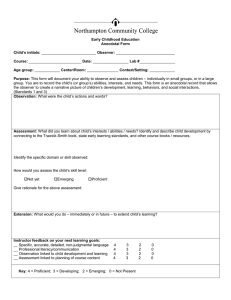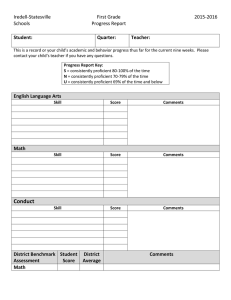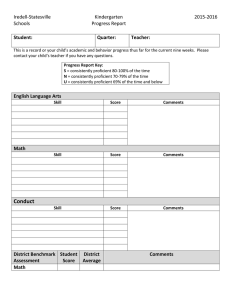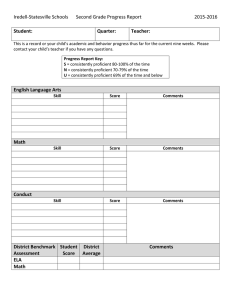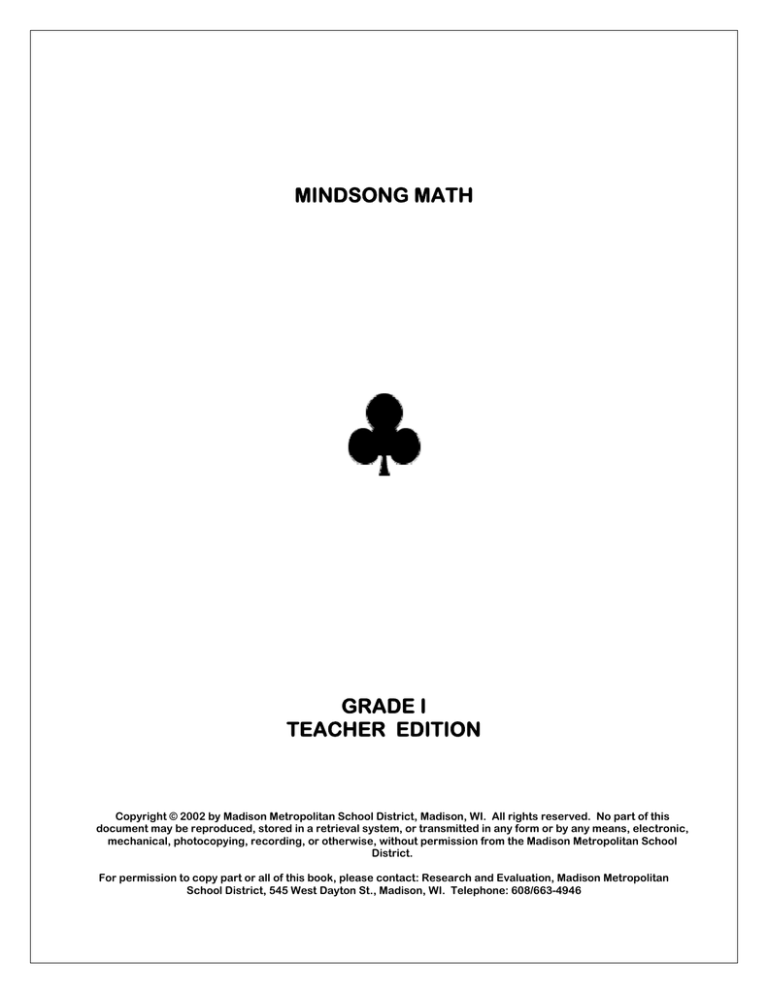
MINDSONG MATH
GRADE I
TEACHER EDITION
Copyright © 2002 by Madison Metropolitan School District, Madison, WI. All rights reserved. No part of this
document may be reproduced, stored in a retrieval system, or transmitted in any form or by any means, electronic,
mechanical, photocopying, recording, or otherwise, without permission from the Madison Metropolitan School
District.
For permission to copy part or all of this book, please contact: Research and Evaluation, Madison Metropolitan
School District, 545 West Dayton St., Madison, WI. Telephone: 608/663-4946
Revised August 2008
Madison Metropolitan School District
PRIMARY MATH ASSESSMENTS
What is the Primary Math Assessment (PMA)?
A Primary Math Assessment contains problems used to assess a student’s progress in understanding
mathematical concepts and in developing problem solving skills. Each item in the PMA is based on
the district’s grade level performance standards. The scoring for each item reflects the 4th quarter
grading guide proficiency levels.
There is a Primary Math Assessment for grade level performance standards at Kindergarten &
grades 1 and 2. Given over time, these assessments provide an opportunity to measure growth in
math proficiencies for each individual student, each school, and the district.
Who Administers the PMA?
It is recommended that the teacher who has the primary responsibility for a student's math
instruction administer the assessments. However, other staff members who co-teach in math class
such as, bilingual resource teachers, special education teachers, Title I, and other support teachers,
may administer assessments to individual students or small groups of students. The PMA’s primary
purpose is to inform instruction, so the decision about who should assess should parallel the answer
to the question; “who instructs?”
Each classroom teacher in Kindergarten, grades 1 and 2 has a PMA assessment kit appropriate to
his/her grade level.
When Is The PMA Administered?
Fall assessment scores are required to be reported to the district’s Planning/Research and
Evaluation team. In addition to the fall assessment, schools may request to implement the PMA
mid-year, as well as in the spring.
Which PMA Level Should Be Administered?
In the fall, a student should complete the PMA level appropriate to the grade level in which that
student is enrolled. The scores on this assessment are reported to the Planning/Research and
Evaluation team. However, a teacher may choose to do further assessment using any levels he or
she believes necessary to learn about a student’s progress. For instance, a teacher may want to
administer all or parts of a PMA for the grade before or following the student’s current grade level
to obtain more information about an individual student or a group of students. The PMA is
intended to inform the instructional decision making of the teacher.
Other than the required fall testing, which must include administration of the student’s current
grade level PMA, teachers may use their discretion to do further assessment at any time, using any
PMA level that helps them know as much as possible about each student’s math progress. If there
are questions regarding next steps for an individual student, consult with your building’s
instructional resource teacher.
Which Students Participate In The Assessment?
Every attempt to understand the mathematical instructional needs of all students should be made.
Assessment of mathematical development is essential for all students including English Language
Learners (ELL) and students with disabilities. General and special education classroom teachers,
support teachers and staff, and building administrators should collaborate when identifying which
students will participate in the assessments. Staff should identify:
1.
2.
3.
which students should participate in the PMA without any accommodations,
which students should participate in the PMA, but with appropriate
accommodations,
and which students should not participate in the PMA assessment.
If an Individualized Education Plan (IEP) exists for a student, decisions regarding participation in
PMA assessments should be based on whatever is specified in the student’s IEP.
English Language Learners (ELL) identified at Level 1, based on the district wide administration of
a consistent language proficiency assessment, and in the country less than six months, should not
participate in the PMA fall testing. ELL at Levels 2 through 6 should be assessed in the language of
instruction.
The assessments can be administered individually, in small groups, or in large groups. Teachers
can determine the order in which items are administered as well as allow as much time as necessary
for students to finish. They can decide the number and length of the testing sessions to best meet
the needs of their students. (All levels of the test are too long to administer in a single testing
period).
District assessment policies follow DPI guidelines in regard to testing decisions. Please make
professional judgments based on your knowledge of each student’s math development.
Collaborate with colleagues when making assessment and programming decisions. Participation in
the PMA, as with all assessment activities in the district, is to be as inclusive as possible.
Test Administration General Directions
1.
The test can be given individually, in small groups, or to the whole class.
2.
The test items can be given in any order.
3.
The length and number of testing sessions should be appropriate for your group.
The test is too long for a single testing period.
4.
The teacher may read the items to the children as often as necessary.
5.
Individual digit reversals are not errors on all problems.
Place value reversal is an error on all problems.
1. Look at the pattern below. Keep the pattern going.
3 (Proficient) for correct answer or 1 (Emerging) for an incorrect answer.
2. Look at the dots.
Circle how many dots in all.
3
10
13
31
3 (Proficient) for correct answer or 1 (Emerging) for an incorrect answer.
3.
Count by 2’s.
Write the numbers.
2
3 (Proficient) for complete correct pattern or 1 (Emerging) for an
incorrect answer.
4. What number comes right after 12 ? __________
What number comes right after 59 ? __________
3 (Proficient) for both correct answers or 1 (Emerging) for an incorrect
answer.
5. What number comes just before 16 ? __________
What number comes just before 40 ? __________
3 (Proficient) for both correct answers or 1 (Emerging) for an incorrect
answer.
6. Write the missing numbers.
1
2
3
4
13
14
22
23
24
25
32
33
34
42
43
11
41
7
8
9
10
17
18
19
20
26
27
28
35
36
37
38
39
40
44
45
46
47
48
49
53
54
55
56
57
58
59
65
66
68
69
78
79
61
62
63
64
71
72
73
74
81
82
92
93
94
5
76
77
85
86
87
95
96
97
3 (Proficient) for all correct answers up to 100
2 (Progressing) for all correct answers up to 50
1 (Emerging) for an incorrect answer.
89
98
99
70
90
7. Look at the boxes of crayons.
There are 10 crayons in each box.
There are also some extra crayons.
COLOR
CRAYONS
COLOR
CRAYONS
COLOR
CRAYONS
COLOR
CRAYONS
COLOR
CRAYONS
How many crayons are there in all ?
Write your answer on the line.
___________ crayons in all
3 (Proficient) for correct answer or 1 (Emerging) for an incorrect
answer.
FOR PROBLEMS 8-21: Tell the students that you will read the story problem twice.
Encourage them not to begin solving the problem until you are finished reading it
the second time. Then reread the problem as many times as you need to for
individual students. Children may use any strategy they choose to solve these
problems. This includes using counters or other manipulatives. Students may use
pictures, tallies, words, or numbers to record their thinking. Their written work
should indicate tool(s) used and action(s) taken. Individual digit reversals are not
errors. Place value reversal is an error.
8.
You had 9 balls.
Your friend gave you 4 more.
How many balls did you have then ?
Write your answer on the line.
___________ balls
3 (Proficient) for correct answer or 1 (Emerging) for an incorrect
answer.
9. Write or draw how you solved this problem.
4 (Advanced) -
if the student solves by using a known or derived fact strategy.
3 (Proficient) -
if student represents a” counting on” strategy on paper. A student can show that
he or she “counted on” by using an empty number line, arrow language or other clear representation.
2 (Progressing) -
if student uses direct modeling to solve or represents the thinking using direct
modeling only
1 (Emerging) - if the student does not solve the problem correctly
10. You had 12 balloons.
3 balloons popped.
How many balloons did you have left ?
Write your answer on the line.
___________ balloons
3 (Proficient) for correct answer or 1 (Emerging) for an incorrect
answer.
11. Write or draw how you solved this problem.
4 (Advanced) -
if the student solves by using a known or derived fact strategy.
3 (Proficient) -
if student represents a” counting on or counting back” strategy on paper. A
student can show that he or she “counted on” by using an empty number line, arrow language or other
clear representation.
2 (Progressing) -
if student uses direct modeling to solve or represents the thinking using direct
modeling only
1 (Emerging) -
if the student does not solve the problem correctly
12. The teacher had 4 boxes of markers.
There were 5 markers in every box.
How many markers did the teacher have ?
Write your answer on the line.
___________ markers
3 (Proficient) for correct answer or 1 (Emerging) for an incorrect
answer.
13. Write or draw how you solved this problem.
4 (Advanced) -
if the student solves by using a known or derived fact strategy, or counts by 4 or
5 and represents either his or her fact knowledge or a count by strategy clearly.
3 (Proficient) -
if student uses direct modeling to solve
1 (Emerging) -
if the student does not solve the problem correctly
14. You had 8 pencils.
The teacher gave you some more.
Then you had 1 1 pencils.
How many pencils did the teacher give you ?
Write your answer on the line.
___________ pencils
3 (Proficient) for correct answer or 1 (Emerging) for an incorrect
answer.
15. Write or draw how you solved this problem.
4 (Advanced) -
if the student solves by using a known or derived fact strategy and represents this
thinking clearly
3 (Proficient) -
if student represents a” counting on” strategy on paper. A student can show that
he or she “counted on” by using an empty number line, arrow language or other clear representation.
2 (Progressing) -
if student uses direct modeling to solve or represents the thinking using direct
modeling only
1 (Emerging) -
if the student does not solve the problem correctly
16. There were 4 bears in the zoo. Color the graph to show 4 bears.
3 (Proficient) for correct boxes colored or 1 (Emerging) for an
incorrect answer.
The Number of Animals Carlos Saw at the Zoo
9
8
Number of Animals
7
6
5
4
3
2
1
Lions
Seals
Camels
Bears
Kinds of Animals
17. Are there more lions or more seals ?
Circle the animal that has more.
How many more ?
___________ more
3 (Proficient) for both correct answers or 1 (Emerging) for an
incorrect answer.
18. Rosa had 15 crackers.
She wants to put 5 crackers in each bag.
How many bags can she fill ?
Write your answer on the line.
___________ bags
3 (Proficient) for correct answer or 1 (Emerging) for an incorrect
answer.
19. Write or draw how you solved this problem.
4 (Advanced)-
if the student solves by using a known or derived fact strategy, or counts by 5 and
represents either his or her fact knowledge or a “count by“ strategy clearly.
3 (Proficient) -
if student uses direct modeling to solve
1 (Emerging) -
if the student does not solve the problem correctly
20. Jonah got 12 fish.
He put them into 3 fish bowls.
He put the same number of fish in each bowl.
How many fish did he put in each bowl ?
Write your answer on the line.
___________ fish
3 (Proficient) for correct answer or 1 (Emerging) for an incorrect
answer.
21. Write or draw how you solved this problem.
4 (Advanced)-
if the student solves by using a known or derived fact strategy, or counts by 3 and
represents either his or her fact knowledge or a” count by” strategy clearly.
3 (Proficient) -
if student uses direct modeling to solve
1 (Emerging) -
if the student does not solve the problem correctly
22. 4 friends are sharing one sandwich.
Draw where you would cut the sandwich so each friend gets about the same
amount.
3 (Proficient) for correct answer (can be cut twice diagonally, 1
vertical/1 horizontal cut or 3 vertical or 3 horizontal cuts) or 1
(Emerging) for an incorrect answer.
23. Measure the marker with Unifix cubes.
How long is the marker ? ___________ cubes long
3 (Proficient) for correct answer or 1 (Emerging) for an incorrect
answer.
24.
Circle all of the triangles.
3 (Proficient) if student circles all 5 triangles or 1 (Emerging) for
an incorrect answer.
25. Draw a line from each coin to its name.
Quarter
Nickel
Penny
Dime
3 (Proficient) for all matched correctly or 1 (Emerging) for an
incorrect answer.
26. Write how many cents each coin is worth.
_______ ¢
_______ ¢
_______ ¢
_______ ¢
3 (Proficient) for all answered correctly or 1 (Emerging) for an
incorrect answer.
27. Look at the equation.
What number goes in the box to make the equation true ?
Write the number in the box.
You may use counters to help you.
3+7 =
= 10 + 4
5-2 =
4+2 =
+2
3 (Proficient) for all answered correctly or 1 (Emerging) for an
incorrect answer.

